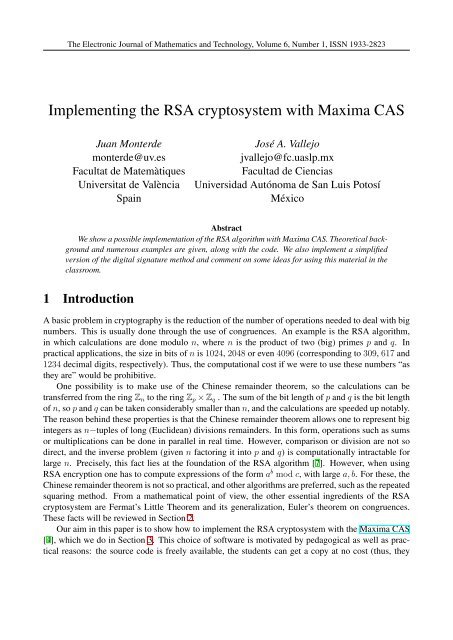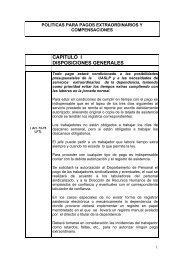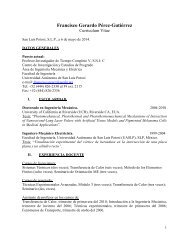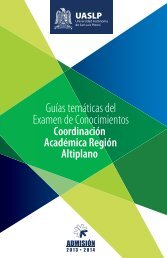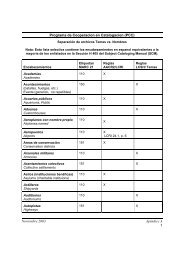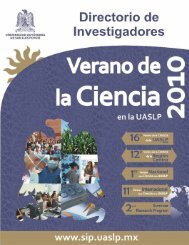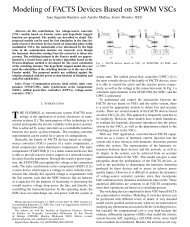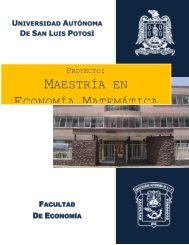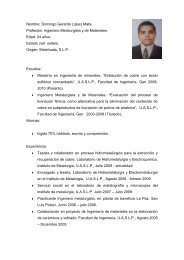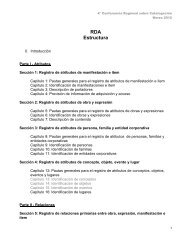Implementing the RSA cryptosystem with Maxima CAS - Facultad de ...
Implementing the RSA cryptosystem with Maxima CAS - Facultad de ...
Implementing the RSA cryptosystem with Maxima CAS - Facultad de ...
Create successful ePaper yourself
Turn your PDF publications into a flip-book with our unique Google optimized e-Paper software.
The Electronic Journal of Ma<strong>the</strong>matics and Technology, Volume 6, Number 1, ISSN 1933-2823<strong>Implementing</strong> <strong>the</strong> <strong>RSA</strong> <strong>cryptosystem</strong> <strong>with</strong> <strong>Maxima</strong> <strong>CAS</strong>Juan Monter<strong>de</strong>monter<strong>de</strong>@uv.esFacultat <strong>de</strong> MatemàtiquesUniversitat <strong>de</strong> ValènciaSpainJosé A. Vallejojvallejo@fc.uaslp.mx<strong>Facultad</strong> <strong>de</strong> CienciasUniversidad Autónoma <strong>de</strong> San Luis PotosíMéxicoAbstractWe show a possible implementation of <strong>the</strong> <strong>RSA</strong> algorithm <strong>with</strong> <strong>Maxima</strong> <strong>CAS</strong>. Theoretical backgroundand numerous examples are given, along <strong>with</strong> <strong>the</strong> co<strong>de</strong>. We also implement a simplifiedversion of <strong>the</strong> digital signature method and comment on some i<strong>de</strong>as for using this material in <strong>the</strong>classroom.1 IntroductionA basic problem in cryptography is <strong>the</strong> reduction of <strong>the</strong> number of operations nee<strong>de</strong>d to <strong>de</strong>al <strong>with</strong> bignumbers. This is usually done through <strong>the</strong> use of congruences. An example is <strong>the</strong> <strong>RSA</strong> algorithm,in which calculations are done modulo n, where n is <strong>the</strong> product of two (big) primes p and q. Inpractical applications, <strong>the</strong> size in bits of n is 1024, 2048 or even 4096 (corresponding to 309, 617 and1234 <strong>de</strong>cimal digits, respectively). Thus, <strong>the</strong> computational cost if we were to use <strong>the</strong>se numbers “as<strong>the</strong>y are” would be prohibitive.One possibility is to make use of <strong>the</strong> Chinese remain<strong>de</strong>r <strong>the</strong>orem, so <strong>the</strong> calculations can betransferred from <strong>the</strong> ring Z n to <strong>the</strong> ring Z p × Z q . The sum of <strong>the</strong> bit length of p and q is <strong>the</strong> bit lengthof n, so p and q can be taken consi<strong>de</strong>rably smaller than n, and <strong>the</strong> calculations are spee<strong>de</strong>d up notably.The reason behind <strong>the</strong>se properties is that <strong>the</strong> Chinese remain<strong>de</strong>r <strong>the</strong>orem allows one to represent bigintegers as n−tuples of long (Eucli<strong>de</strong>an) divisions remain<strong>de</strong>rs. In this form, operations such as sumsor multiplications can be done in parallel in real time. However, comparison or division are not sodirect, and <strong>the</strong> inverse problem (given n factoring it into p and q) is computationally intractable forlarge n. Precisely, this fact lies at <strong>the</strong> foundation of <strong>the</strong> <strong>RSA</strong> algorithm [7]. However, when using<strong>RSA</strong> encryption one has to compute expressions of <strong>the</strong> form a b mod c, <strong>with</strong> large a, b. For <strong>the</strong>se, <strong>the</strong>Chinese remain<strong>de</strong>r <strong>the</strong>orem is not so practical, and o<strong>the</strong>r algorithms are preferred, such as <strong>the</strong> repeatedsquaring method. From a ma<strong>the</strong>matical point of view, <strong>the</strong> o<strong>the</strong>r essential ingredients of <strong>the</strong> <strong>RSA</strong><strong>cryptosystem</strong> are Fermat’s Little Theorem and its generalization, Euler’s <strong>the</strong>orem on congruences.These facts will be reviewed in Section 2.Our aim in this paper is to show how to implement <strong>the</strong> <strong>RSA</strong> <strong>cryptosystem</strong> <strong>with</strong> <strong>the</strong> <strong>Maxima</strong> <strong>CAS</strong>[4], which we do in Section 3. This choice of software is motivated by pedagogical as well as practicalreasons: <strong>the</strong> source co<strong>de</strong> is freely available, <strong>the</strong> stu<strong>de</strong>nts can get a copy at no cost (thus, <strong>the</strong>y
The Electronic Journal of Ma<strong>the</strong>matics and Technology, Volume 6, Number 1, ISSN 1933-2823can work at home <strong>with</strong> <strong>the</strong> same program <strong>the</strong>y use at <strong>the</strong> classroom), <strong>the</strong> <strong>de</strong>velopers are very activeand accessible, and <strong>the</strong> commands and syntax are very intuitive (some of <strong>the</strong> <strong>Maxima</strong> syntaxis merely a translation of <strong>the</strong> plain English used to <strong>de</strong>scribe <strong>the</strong> ma<strong>the</strong>matical operations, such asintegrate(xˆ2,x,0,1): “integrate x 2 <strong>with</strong> respect to x between 0 and 1”). These reasons almostcoinci<strong>de</strong> <strong>with</strong> <strong>the</strong> ones expressed by A. McAndrew in [5], a paper which <strong>de</strong>scribes in great <strong>de</strong>tail<strong>the</strong> use of <strong>Maxima</strong> and Axiom in teaching a course on cryptography (for an interesting alternative, seealso [6], where SAGE is used instead of <strong>Maxima</strong>). In<strong>de</strong>ed, <strong>the</strong> present paper is based on a 10−hoursummer course given by one of <strong>the</strong> authors (JM) to stu<strong>de</strong>nts of ma<strong>the</strong>matics, physics and engineering,ranging from first-year to post-graduates. Our conclusions are also similar to those of McAndrew in[5] (<strong>Maxima</strong> is particularly well suited for basic cryptography), so we refer to his paper for a justificationof <strong>the</strong> educational aspects and focus our attention on <strong>the</strong> technical <strong>de</strong>tails: <strong>the</strong> ma<strong>the</strong>maticalfoundation of <strong>the</strong> <strong>RSA</strong> <strong>cryptosystem</strong> and its practical implementation on <strong>Maxima</strong>.In Section 4 we show how to apply <strong>the</strong> <strong>RSA</strong> techniques to guarantee <strong>the</strong> authorship of a message,through <strong>the</strong> use of digital signatures. We inclu<strong>de</strong> sample co<strong>de</strong>s for all <strong>the</strong> functions <strong>de</strong>scribedin <strong>the</strong> text along <strong>with</strong> examples of <strong>the</strong>ir usage, so <strong>the</strong> paper is relatively self-contained. Informationabout <strong>the</strong> use of <strong>Maxima</strong> can be found in <strong>the</strong> page http://maxima.sourceforge.net/documentation.html.Section 5 offers some comments about how to use <strong>the</strong> present material in actual cryptographycourses.Some technical <strong>de</strong>tails about <strong>the</strong> software used:The version of <strong>Maxima</strong> was 5.24.0, <strong>with</strong> <strong>the</strong> interface wx<strong>Maxima</strong> (version 11.04.0). Both canbe downloa<strong>de</strong>d for free from http://maxima.sourceforge.net/download.html andhttp://andrejv.github.com/wxmaxima, respectively.The co<strong>de</strong> examples assume that <strong>the</strong> messages are written in pure ASCII (not exten<strong>de</strong>d), to avoidsome problems <strong>with</strong> <strong>the</strong> XML ren<strong>de</strong>ring of non printable characters in wx<strong>Maxima</strong>. When expressing<strong>the</strong> path to a file, we assume that <strong>the</strong> user has a Linux R○ or Mac OSX R○ system. For MS Windows R○ ,little changes are required.The source co<strong>de</strong> for <strong>the</strong> programs presented in this paper, suppressed outputs and some relatedmaterial, can be found at http://galia.fc.uaslp.mx/˜jvallejo/Software.html.2 Algebraic preliminaries2.1 Modular arithmeticWe begin by recalling Euclid’s algorithm. To compute <strong>the</strong> greatest common divisor (gcd) of twointegers a, b ∈ Z, first divi<strong>de</strong> a by b to find <strong>the</strong> quotient q 1 and <strong>the</strong> remain<strong>de</strong>r r 1 :a = q 1 · b + r 1 .Then, repeat <strong>the</strong> process substituting a by b and b by r 1 :Repeat again, this time using r 1 and r 2 , to find:b = q 2 · r 1 + r 2 .r 1 = q 3 · r 2 + r 3 .35
The Electronic Journal of Ma<strong>the</strong>matics and Technology, Volume 6, Number 1, ISSN 1933-2823The algorithm continues this way until one of <strong>the</strong> r i divi<strong>de</strong>s r i−1 . In this case, gcd(a, b) = r i−1 . Notethat <strong>the</strong> process ends after a finite number of steps, as in each one of <strong>the</strong>m we have r i < r i−1 .Example 1 To compute gcd(1547, 560), we proceed as follows:As 7|21, we are done: gcd(1547, 560) = 7.<strong>Maxima</strong> has a function to compute <strong>the</strong> gcd:1547 = 2 · 560 + 427;560 = 1 · 427 + 133;427 = 3 · 133 + 28;133 = 4 · 28 + 21;28 = 1 · 21 + 7.(%i1)gcd(1547,560);(%o1) 7A basic fact from Number Theory is <strong>the</strong> following: If d = gcd(a, b), <strong>with</strong> a > b, <strong>the</strong>re exist twointegers u, v such thatd = ua + vb.This is called <strong>the</strong> Bézout i<strong>de</strong>ntity (see [2], Section 1.2).Example 2 We have just seen that gcd(1547, 560) = 7. Let us find u, v such that 7 = u·1547+v·560.We can use <strong>the</strong> intermediate steps in Euclid’s algorithm, but reversing direction (from end to start):7 = 28 − 1 · 21= 28 − (133 − 4 · 28) = −133 + 5 · 28= −133 + 5 · (427 − 3 · 133) = 5 · 427 − 16 · 133= 5 · 427 − 16 · (560 − 427) = −16 · 560 + 21 · 427= −16 · 560 + 21 · (1547 − 2 · 560) = 21 · 1547 − 58 · 560.Thus,7 = 21 · 1547 − 58 · 560.The <strong>Maxima</strong> command gc<strong>de</strong>x does <strong>the</strong> same:(%i2)gc<strong>de</strong>x(1547,560);(%o2) [21, −58, 7]As a direct application of <strong>the</strong> Bézout i<strong>de</strong>ntity, we have that <strong>the</strong> invertible elements for <strong>the</strong> productin 1 Z/mZ, are precisely those coprimes <strong>with</strong> m. In o<strong>the</strong>r words: <strong>the</strong> integers a for which <strong>the</strong>re existsa b such that ab ≡ 1 (mod m), are precisely those a satisfying gcd(a, m) = 1.1 This is <strong>the</strong> ring formed by <strong>the</strong> equivalence classes <strong>de</strong>termined by <strong>the</strong> binary relation “congruence modulo m”: twointegers a, b ∈ Z are congruent modulo m iff <strong>the</strong>ir difference a−b is a multiple of m. In this case we write a ≡ b (mod m).36
The Electronic Journal of Ma<strong>the</strong>matics and Technology, Volume 6, Number 1, ISSN 1933-2823Example 3 Modulo 841, <strong>the</strong> integer 160 is invertible. In<strong>de</strong>ed, 841 = 29 2 while 160 = 2 5 · 5. Thus,gcd(841, 160) = 1. Its inverse is 205, since160 · 205 − 1 = 32800 − 1 = 32799 = 39 · 841.<strong>Maxima</strong> can compute <strong>the</strong> inverse of n modulo m directly <strong>with</strong> <strong>the</strong> command inv mod:(%i3)inv_mod(160,841);(%o3) 205The properties of modular arithmetic are similar to those of integer arithmetic. To name a few(see [1], Chapter 5):1. a ≡ a (mod m), for all a ∈ Z.2. a ≡ b (mod m) if and only if b ≡ a (mod m), for all a, b ∈ Z.3. If a ≡ b (mod m) and b ≡ c (mod m), <strong>the</strong>n a ≡ c (mod m), for all a, b, c ∈ Z.4. If a ≡ b (mod m) and c ≡ d (mod m), <strong>the</strong>n a + c ≡ b + d (mod m) and a · c ≡ b · d (mod m),for all a, b, c, d ∈ Z.5. If a ≡ b (mod m), <strong>the</strong>n if a ≡ b (mod d) for each divisor of m, d.6. If a ≡ b (mod m), and a ≡ b (mod n), <strong>with</strong> m, n coprimes, <strong>the</strong>n a ≡ b (mod m · n).We now recall a classical result (see [1], Chapter 5). Fermat’s Little Theorem says that if p is aprime number, <strong>the</strong>n for any integer a we haveand, for every integer a not divisible by p:a p ≡ a (mod p),a p−1 ≡ 1 (mod p). (1)An immediate consequence is <strong>the</strong> following. If a is not divisible by p and n ≡ m (mod (p − 1)), <strong>the</strong>na n ≡ a m (mod p).Example 4 Let us find <strong>the</strong> last digit of 2 1000000 when written in base 7. This is just <strong>the</strong> remain<strong>de</strong>rof 2 1000000 modulo 7. In or<strong>de</strong>r to apply <strong>the</strong> result above, we must reduce <strong>the</strong> exponent. If we takep = 7, n = 1000000, we must find a suitable m such that 1000000 ≡ m (mod 6). Since 1000000 =166666 · 6 + 4, this means that we can take m = 4. Applying now <strong>the</strong> corollary to Fermat’s LittleTheorem, we find2 1000000 ≡ 2 4 = 16 ≡ 2 (mod 7).Thus, <strong>the</strong> last digit of 2 1000000 when written in base 7 is 2.37
The Electronic Journal of Ma<strong>the</strong>matics and Technology, Volume 6, Number 1, ISSN 1933-28232.2 The Chinese remain<strong>de</strong>r <strong>the</strong>oremThe original form of <strong>the</strong> <strong>the</strong>orem, appearing in a book written by <strong>the</strong> Chinese ma<strong>the</strong>matician QinJiushao and published in 1247, is a result related to systems of congruences. It is possible to find aprece<strong>de</strong>nt in <strong>the</strong> Sunzi suanjing, a book from <strong>the</strong> third century written by Sun Zi:Han Xing asks how many soldiers are in his army. If you let <strong>the</strong>m para<strong>de</strong> in rows of 3soldiers, two soldiers will be left. If you let <strong>the</strong>m para<strong>de</strong> in rows of 5, 3 will be left, andin rows of 7, 2 will be left. How many soldiers are <strong>the</strong>re?.The mo<strong>de</strong>rn formulation of <strong>the</strong> problem is <strong>the</strong> following. Let m 1 , m 2 , ..., m k be integers that aregreater than one and pairwise coprime, and let a 1 , a 2 , ..., a k be any integers. Then <strong>the</strong>re exists aninteger x such that x ≡ a i (mod m i ) for each i ∈ {1, 2, ..., k}. Fur<strong>the</strong>rmore, for any o<strong>the</strong>r integer ythat satisfies all <strong>the</strong> congruences, y ≡ x (mod M) where M = m 1 · · · m k . Note that <strong>the</strong>re is only onesolution in {0, 1, ..., M}.The proof of <strong>the</strong> <strong>the</strong>orem (which can be found in Theorem 5.26 of [1]) gives an algorithm to findx. The following co<strong>de</strong> implements it in <strong>Maxima</strong> (it returns <strong>the</strong> lowest positive solution modulo M):Beginning of co<strong>de</strong>chinese_remain<strong>de</strong>r(a,k):=block([K,L,x],K:makelist(apply("*",<strong>de</strong>lete(k[i],k)),i,1,length(k)),L:makelist(first(gc<strong>de</strong>x(K[i],k[i])),i,1,length(k)),x:mod(sum(a[i]*K[i]*L[i],i,1,length(k)),apply("*",k)),x);End of co<strong>de</strong>To use it, just write chinese remain<strong>de</strong>r([a1,...,ar],[m1,...,mr]). For <strong>the</strong> HanXing’s example:(%i4)chinese_remain<strong>de</strong>r([2,3,2],[3,5,7]);(%o4) 23A small army, in<strong>de</strong>ed. Surely, this is one example in which <strong>the</strong> solution is not <strong>the</strong> one in {0, 1, ..., M}(as in this case Han Xing would have not nee<strong>de</strong>d to ask for <strong>the</strong> number of soldiers, being easy to count<strong>the</strong>m by himself), but one of <strong>the</strong> infinite numbers congruent <strong>with</strong> 23 modulo M = 7 · 5 · 3 = 105, thatis: 128, 233, etcetera.2.3 Euler’s <strong>the</strong>oremConsi<strong>de</strong>r Example 4 again. What if we are asked for <strong>the</strong> last digit in base 77?. We can not applyFermat’s <strong>the</strong>orem here, because 77 is composite. Euler found a generalization of Fermat’s <strong>the</strong>orem tothis case, introducing his totient function ϕ(n) (which gives <strong>the</strong> number of positive integers less than38
The Electronic Journal of Ma<strong>the</strong>matics and Technology, Volume 6, Number 1, ISSN 1933-2823or equal to n that are coprime to n).In <strong>Maxima</strong> we have <strong>the</strong> command totient:(%i5)totient(77);(%5) 60Now, Euler’s <strong>the</strong>orem says that for every a ∈ Z:a ϕ(n) ≡ 1 (mod n).Example 5 Let us compute <strong>the</strong> last digit of 2 1000000 in base 77. As ϕ(77) = 60, we know that2 60 ≡ 1 (mod 77). As 1000000 = 16666 · 60 + 40, <strong>the</strong>n 2 1000000 ≡ 2 40 (mod 77). Now, it is easy tocompute 2 40 (mod 77). For instance2 10 = 1024 = 13 · 77 + 23 ≡ 23 (mod 77),and 2 40 = 2 10·4 = 23 4 ≡ 23 (mod 77). Thus, <strong>the</strong> last digit of 2 1000000 in base 77 is 3.2.4 The <strong>Maxima</strong> function power modAs we have seen in Example 5, a basic computation one often encounters in modular arithmetic is<strong>the</strong> modular exponentiation when both <strong>the</strong> exponent and <strong>the</strong> modulus are very large. As mentioned,<strong>the</strong> Chinese remain<strong>de</strong>r <strong>the</strong>orem or <strong>the</strong> Euler’s <strong>the</strong>orem can be of some help to compute modular exponentiation.Never<strong>the</strong>less, <strong>the</strong>re is in <strong>Maxima</strong> a simple way to compute such exponentiation <strong>with</strong>outusing <strong>the</strong>se results.The modular power function power mod(a,b,c) gives exactly <strong>the</strong> result of a b (mod c) forb > 0:(%i6)(%o6) 23power_mod(2,40,77);However, power mod is much more efficient than <strong>the</strong> Chinese remain<strong>de</strong>r or Euler’s <strong>the</strong>orems,because it avoids generating <strong>the</strong> full form of a b . The algorithm to compute modular exponentiationfollows <strong>the</strong> repeated squaring method: Instead of repeated multiplication of a by itself, what this algorithmdoes is to reduce any partial result modulo c, immediately after a multiplication is performed.In that way we never encounter any integers greater than c 2 (see [8] for <strong>de</strong>tails on this method). In ourimplementation of <strong>the</strong> <strong>RSA</strong> <strong>cryptosystem</strong> we will use <strong>the</strong> power mod function, and so, <strong>the</strong> repeatedsquaring method implicitly.39
The Electronic Journal of Ma<strong>the</strong>matics and Technology, Volume 6, Number 1, ISSN 1933-28233 The <strong>RSA</strong> <strong>cryptosystem</strong>3.1 Caesar cipherThe first documented <strong>cryptosystem</strong> is very simple. It just replaces each letter in <strong>the</strong> plain text <strong>with</strong><strong>the</strong> one sitting three positions down <strong>the</strong> alphabet, for example, we would replace A by D, B by E, andso on (<strong>the</strong> last three letters, X, Y, Z, are replaced by A, B, C, respectively). It seems that this methodwas used by Julius Caesar to send military instructions to his generals.This i<strong>de</strong>a can be translated to numbers, for an easier use. If we replace each letter of <strong>the</strong> alphabetby a natural number (adding <strong>the</strong> space between words character) as ina b c d e f g h i j k l · · · r s t u v w x y z0 1 2 3 4 5 6 7 8 9 10 11 12 · · · 18 19 20 21 22 23 24 25 26<strong>the</strong>n <strong>the</strong> encryption function is simplyf(x) = x + 3 (mod 27),while <strong>the</strong> <strong>de</strong>cryption function is, obviously, <strong>the</strong> inverse:g(x) = f −1 (x) = x − 3 (mod 27).These simple properties make <strong>the</strong> Caesar cipher very easy to use. However, <strong>the</strong>y are also <strong>the</strong> origin ofits weakness. To break a <strong>cryptosystem</strong> means to <strong>de</strong>duce <strong>the</strong> encryption/<strong>de</strong>cryption functions from asample of ciphertext (<strong>the</strong> encrypted message); in this case, <strong>the</strong> method of attack is a simple frequencyanalysis of word repetitions (in English, for instance, <strong>the</strong> most repeated number corresponds to <strong>the</strong>most used letter, <strong>the</strong> e, <strong>the</strong> second is <strong>the</strong> t, and so on).Several schemes were <strong>de</strong>vised to improve <strong>the</strong> Caesar cipher. For instance, one could try morecomplicated bijections, such asf(x) = a · x + b (mod 27),<strong>with</strong> a an integer such that gcd(a, 27) = 1, and a, b ∈ {1, 2, ..., 26}. Ano<strong>the</strong>r possibility consistsin taking groups of contiguous letters, instead of one by one; for example, digraphs (groups of twoletters) or trigraphs (groups of three letters). In this case, an encryption function could have <strong>the</strong> formf(x) = a · x + b (mod m),where a, b ∈ {1, 2, ..., m − 1} and m is a number big enough to allow for <strong>the</strong> enumeration (in aone-to-one and onto manner) of every possible combination of three characters. Both parameters, aand m, are necessary for <strong>the</strong> encryption as well as <strong>the</strong> <strong>de</strong>cryption processes, and are called <strong>the</strong> key of<strong>the</strong> <strong>cryptosystem</strong>.Anyway, <strong>the</strong>se systems are too weak to be used in practice. They can be broken in a number ofways, very easily <strong>with</strong> <strong>the</strong> use of a mo<strong>de</strong>rn computer. We have cited <strong>the</strong>m here just for <strong>the</strong> sake ofillustration of <strong>the</strong> concepts involved.40
The Electronic Journal of Ma<strong>the</strong>matics and Technology, Volume 6, Number 1, ISSN 1933-28233.2 Public key <strong>cryptosystem</strong>sA revolution happened when <strong>the</strong> so called public key <strong>cryptosystem</strong>s appeared, in <strong>the</strong> late seventies.These systems are based on <strong>the</strong> following fact: <strong>the</strong>re are bijective (one-to-one and onto) functions forwhich <strong>the</strong> calculation of <strong>the</strong> inverse is very difficult, computationally impossible. Then, we can makepublicly available <strong>the</strong> keys used to encrypt messages whenever <strong>the</strong> keys used for <strong>de</strong>cryption are to befound by one of <strong>the</strong>se functions. One example is <strong>the</strong> factorization of a given number into a product ofprimes, and this fact is <strong>the</strong> foundation of <strong>the</strong> <strong>RSA</strong> method (see [7]).In a public key <strong>cryptosystem</strong>, each user has a public key, that is, an encryption function f pub , anda private key, a <strong>de</strong>cryption function f pri , which are inverses one of ano<strong>the</strong>r: f pri = f −1pub. Thus, ifa user A wants to send a message (say, “text”, translated to numbers as in <strong>the</strong> preceding section to“2052420”) to a user B, she must look in <strong>the</strong> public keys listing <strong>the</strong> one corresponding to B (say,fpub B ), apply it to <strong>the</strong> message (obtaining f pub B (2052420)), and send it to B. Even in <strong>the</strong> unfortunateevent that someone intercepts <strong>the</strong> ciphered text, only B knows <strong>the</strong> <strong>de</strong>cryption function. In<strong>de</strong>ed, userB can read <strong>the</strong> original message by just applying fpri B = ( fpub) B −1to fBpub (2052420); thus:3.3 The <strong>RSA</strong> algorithmf B pri(fBpub (2052420) ) = ( f B pub) −1 (fBpub (2052420) ) = 2052420.As stated in <strong>the</strong> preceding subsection, to implement <strong>the</strong> <strong>RSA</strong> <strong>cryptosystem</strong> we only need to give <strong>the</strong>pair of functions (f pub , f pri ) for each user, A, of <strong>the</strong> system. The procedure is <strong>the</strong> following:1. User A chooses two large prime numbers, p A and q A .2. Calculate <strong>the</strong> product n A = p A · q A .3. Evaluate <strong>the</strong> totient function 2 on n A , Φ(n A )4. Choose a number e A ∈ {1, 2, ..., Φ(n A )}, coprime <strong>with</strong> Φ(n A ).With <strong>the</strong>se choices, gcd(e A , Φ(n A )) = 1, so e A is an invertible element of <strong>the</strong> ring Z/Φ(n A )Z. Letd A be an integer such that its equivalence class is <strong>the</strong> inverse of that of e A , that is,e A · d A ≡ 1 (mod Φ(n A )).5. The encryption function, f A pub : Z/n AZ → Z/n A Z, is given byf A pub(m) = m e A(mod n A ).2 Note that in this case, <strong>with</strong> n A semiprime (that is, <strong>the</strong> product of two primes), we haveΦ(n A ) = (p A − 1) · (q A − 1) = n A − p A − q A − 1.41
The Electronic Journal of Ma<strong>the</strong>matics and Technology, Volume 6, Number 1, ISSN 1933-28236. The <strong>de</strong>cryption function, fpri, A is <strong>the</strong> inverse of fpub A , that is:f A pri(m) = m d A(mod n A ).It is instructive to check that <strong>the</strong>se functions are in<strong>de</strong>ed inverses of each o<strong>the</strong>r.Theorem 6 For every m ∈ Z/n A Z,f A pri(f A pub(m)) ≡ f A pri(m e A) ≡ m e A·d A≡ m (mod n A ).Proof. For simplicity, we will drop <strong>the</strong> subscripts A. We can assume that m is not divisible 3 by p.Then, by Fermat’s Little Theorem (1),m p−1 ≡ 1 (mod p).Let us take <strong>the</strong> power of q − 1 on both si<strong>de</strong>s of this equation:m (p−1)·(q−1) = ( m p−1) q−1≡ 1 q−1 = 1 (mod p).A similar computation, interchanging p and q, givesm (p−1)·(q−1) = ( m q−1) p−1≡ 1 p−1 = 1 (mod q).We can apply <strong>the</strong> property 6 of modular arithmetic, to getNote that for any integer k we will also havem (p−1)·(q−1) = 1 (mod pq).m k·(p−1)·(q−1) = ( m (p−1)·(q−1)) k≡ 1 k = 1 (mod pq).Now, recall that e · d ≡ 1 (mod Φ(n) = (p − 1) · (q − 1)). That meansThus:e · d = 1 + k · (p − 1) · (q − 1).m e·d = m 1+k·(p−1)·(q−1) = m · m k·(p−1)·(q−1) ≡ m · 1 = m (mod pq),so m e·d ≡ m (mod n), as we inten<strong>de</strong>d to prove.Why is this method secure?. In <strong>the</strong> <strong>RSA</strong> <strong>cryptosystem</strong>, <strong>the</strong> public key of user A is <strong>the</strong> pair ofintegers (e A , n A ), while her private key is <strong>the</strong> pair (d A , n A ). To find <strong>the</strong> private key knowing <strong>the</strong>public key is equivalent to computing <strong>the</strong> integer d A knowing e A and n A . Thus, if we want to break<strong>the</strong> <strong>cryptosystem</strong>, we must first calculate Φ(n A ) = (p A − 1)(q A − 1), that is, we must factor n A as <strong>the</strong>product of two primes. This is an extremely difficult problem from <strong>the</strong> computational point of view;in<strong>de</strong>ed, a joint effort of several researchers using hundreds of <strong>de</strong>dicated computers only could factora 232−digit number after two years of computation (see [3]). Note that this number corresponds toa 768−bit encryption, <strong>the</strong> problem of factoring a 1024−bit key is a thousand times har<strong>de</strong>r! Thus,although breaking <strong>the</strong> <strong>RSA</strong> <strong>cryptosystem</strong> is <strong>the</strong>oretically possible, it is practically impossible <strong>with</strong>our current state of knowledge.3 That p divi<strong>de</strong> m is highly improbable, given <strong>the</strong> magnitu<strong>de</strong> or<strong>de</strong>r of <strong>the</strong> prime p.42
The Electronic Journal of Ma<strong>the</strong>matics and Technology, Volume 6, Number 1, ISSN 1933-28233.4 Implementation in <strong>Maxima</strong> <strong>CAS</strong>The following function generates a list (e, n, d) suitable for use in <strong>the</strong> <strong>RSA</strong> algorithm.(load(distrib));Beginning of co<strong>de</strong>generate_random_key(l):=block([p,q,n,r,e,d,K],p:next_prime(floor(float(random_continuous_uniform(2ˆl,2ˆ(l+1))))),q:next_prime(floor(float(random_continuous_uniform(2ˆl,2ˆ(l+1))))),n:p*q,r:(p-1)*(q-1),e:next_prime(floor(float(random(floor(r/2))))),d:inv_mod(e,r),K:[e,n,d],K);End of co<strong>de</strong>To use it write generate random key(l) where l <strong>de</strong>termines <strong>the</strong> number of digits of <strong>the</strong>integers e, n, d (<strong>the</strong>y will be pseudo-randomly generated between 2 l and 2 l+1 ). A suggested value(to speed up computations while keeping practical interest for applications) is l = 125. Note that<strong>the</strong> construction of e is based on <strong>the</strong> obvious consequence of <strong>the</strong> Prime Number Theorem 4 that <strong>the</strong>number of primes between r/2 and r (for large r) is approximately r/log(r/2), so <strong>the</strong>se are relativelyabundant.For example:(%i7)key:generate_random_key(125);(%o7) [671258217454686505293403265373669737061769832160804966205145423006710890659,6524380046621073928456206976859918286968722163998541593398840097117692758107,4117416708352497196549341588732382167090260042357291528574523538009688319619]Once we have <strong>the</strong> list (e, n, d) as <strong>the</strong> output of generate random key, we can create our publickey (e, n):(%i8)public_key:rest(key,-1);(%o8) [671258217454686505293403265373669737061769832160804966205145423006710890659,that4 Let π(x) be <strong>the</strong> function giving <strong>the</strong> number of primes less than or equal to x. Then, <strong>the</strong> Prime Number Theorem sayslimx→+∞π(x)x/ln(x) = 1.43
The Electronic Journal of Ma<strong>the</strong>matics and Technology, Volume 6, Number 1, ISSN 1933-28236524380046621073928456206976859918286968722163998541593398840097117692758107]and our private key (d, n):(%i9)private_key:reverse(rest(key,1));(%o9) [4117416708352497196549341588732382167090260042357291528574523538009688319619,6524380046621073928456206976859918286968722163998541593398840097117692758107]The next function rsa encrypt reads a text from a file and encrypts it in blocks of length k.(load(stringproc));Beginning of co<strong>de</strong>file_to_string(u):=block([a,i:0,text_string,tmp],a:openr(u),while stringp(tmp[i]:readline(a)) do i:i+1,text_string:simplo<strong>de</strong>(makelist(tmp[j],j,0,i-1)," "),text_string);rsa_encrypt_console(s,k,P):=block([tmp,ad<strong>de</strong>d_char,encrypted_text,encrypted_text_ad<strong>de</strong>d],local(fill_string,string_to_number,rsa_enco<strong>de</strong>),tmp:smake(k-(slength(s)-k*floor(slength(s)/k)),ascii(126)),ad<strong>de</strong>d_char:[slength(tmp)],fill_string(s,k):=concat(s,tmp),string_to_number(s):=sum((cint(charat(s,i))-32)*95ˆ(i-1),i,1,slength(s)),rsa_enco<strong>de</strong>(a,b,c):=power_mod(a,b,c),encrypted_text:makelist(rsa_enco<strong>de</strong>(string_to_number(substring(fill_string(s,k), 1+k*(i-1), 1+k*i)),P[1],P[2]), i, 1, slength(fill_string(s,k))/k),encrypted_text_ad<strong>de</strong>d:append(ad<strong>de</strong>d_char,encrypted_text));rsa_encrypt_file(s,k,P,p):=block([LL],LL:rsa_encrypt_console(s,k,P),44
The Electronic Journal of Ma<strong>the</strong>matics and Technology, Volume 6, Number 1, ISSN 1933-2823);stringout(p,LL)rsa_encrypt(q,k,P,[p]):=block([t],t:file_to_string(q),if p=[] <strong>the</strong>n rsa_encrypt_console(t,k,P)else rsa_encrypt_file(t,k,P,first(p)));End of co<strong>de</strong>The result can be shown in <strong>the</strong> console or, if a path to a file is given, written to that file. For <strong>the</strong>purpose of this example, we have stored <strong>the</strong> following text in /root/hysteria.txt:As she laughed I was aware of becoming involved in her laughter and being part of it,until her teeth were only acci<strong>de</strong>ntal stars <strong>with</strong> a talent for squad-drill. I was drawn in byshort gasps, inhaled at each momentary recovery, lost finally in <strong>the</strong> dark caverns of herthroat, bruised by <strong>the</strong> ripple of unseen muscles. An el<strong>de</strong>rly waiter <strong>with</strong> trembling handswas hurriedly spreading a pink and white checked cloth over <strong>the</strong> rusty green iron table,saying: ”If <strong>the</strong> lady and gentleman wish to take <strong>the</strong>ir tea in <strong>the</strong> gar<strong>de</strong>n, if <strong>the</strong> lady andgentleman wish to take <strong>the</strong>ir tea in <strong>the</strong> gar<strong>de</strong>n ...” I <strong>de</strong>ci<strong>de</strong>d that if <strong>the</strong> shaking of herbreasts could be stopped, some of <strong>the</strong> fragments of <strong>the</strong> afternoon might be collected, andI concentrated my attention <strong>with</strong> careful subtlety to this end.We can encrypt <strong>the</strong> text in blocks of length 5 k = 20 <strong>with</strong> <strong>the</strong> following commands (<strong>the</strong> output issuppressed because of its length):(%i10) load(rsa_encrypt)$(%i11) rsa_encrypt("/root/hysteria.txt",20,public_key);Or we can redirect <strong>the</strong> output to a file, in this example /root/hysteria-encrypted.txt:(%i12) rsa_encrypt("/root/hysteria.txt",20,public_key,"/root/hysteria-encrypted.txt");(%o12) /root/hysteria − encrypted.txtThe function given below, rsa <strong>de</strong>crypt, reads encrypted text from a file and <strong>de</strong>crypts it.(load(basic));Beginning of co<strong>de</strong>5 Here, <strong>the</strong> particular value k = 20 is chosen just as an example. In Section 5, k = 3 is taken instead. What one shouldkeep in mind when choosing <strong>the</strong> value of k is that <strong>the</strong> numerical representation of each block must have a value less than<strong>the</strong> modulus if <strong>the</strong> message is to be <strong>de</strong>crypted successfully.45
The Electronic Journal of Ma<strong>the</strong>matics and Technology, Volume 6, Number 1, ISSN 1933-2823rsa_<strong>de</strong>crypt_console(M,k,Q):=block([clean_message],local(number_to_string,rsa_<strong>de</strong>co<strong>de</strong>),number_to_string(z,k):=makelist(ascii(mod(floor(z/(95ˆ(i-1))),95)+32),i,1,k),rsa_<strong>de</strong>co<strong>de</strong>(a,b,c):=power_mod(a,b,c),clean_message:simplo<strong>de</strong>(makelist(simplo<strong>de</strong>(number_to_string(rsa_<strong>de</strong>co<strong>de</strong>(M[i],Q[1],Q[2]),k)),i,1,length(M))),clean_message);rsa_<strong>de</strong>crypt(s,k,Q,[p]):=block([prelist,AA,BB,len],prelist:read_list(s,comma),AA:rest(rest(prelist,-2),1),BB:pop(AA),len:slength(rsa_<strong>de</strong>crypt_console(AA,k,Q)),if p=[] <strong>the</strong>nsubstring(rsa_<strong>de</strong>crypt_console(AA,k,Q),1,len-(BB-1))elsestringout(first(p),substring(rsa_<strong>de</strong>crypt_console(AA,k,Q),1,len-(BB-1))));End of co<strong>de</strong>Again, <strong>the</strong> function can show <strong>the</strong> clean text in <strong>the</strong> console or, if a path to a file is given, to store<strong>the</strong> <strong>de</strong>crypted text in that file. In <strong>the</strong> example, we <strong>de</strong>co<strong>de</strong> <strong>the</strong> text that was previously encrypted andstored in /root/hysteria-encrypted.txt. Note also that <strong>the</strong> length of <strong>the</strong> blocks (k = 20)is passed as an argument:(%i13) rsa_<strong>de</strong>crypt("/root/hysteria-encrypted.txt",20,private_key);(%o13) As she laughed I was aware of becoming involved in her laughter and being part of it, untilher teeth were only acci<strong>de</strong>ntal stars <strong>with</strong> a talent for squad-drill. I was drawn in by short gasps, inhaledat each momentary recovery, lost finally in <strong>the</strong> dark caverns of her throat, bruised by <strong>the</strong> rippleof unseen muscles. An el<strong>de</strong>rly waiter <strong>with</strong> trembling hands was hurriedly spreading a pink and whitechecked cloth over <strong>the</strong> rusty green iron table, saying: ”If <strong>the</strong> lady and gentleman wish to take <strong>the</strong>ir46
The Electronic Journal of Ma<strong>the</strong>matics and Technology, Volume 6, Number 1, ISSN 1933-2823tea in <strong>the</strong> gar<strong>de</strong>n, if <strong>the</strong> lady and gentleman wish to take <strong>the</strong>ir tea in <strong>the</strong> gar<strong>de</strong>n ...” I <strong>de</strong>ci<strong>de</strong>d that if <strong>the</strong>shaking of her breasts could be stopped, some of <strong>the</strong> fragments of <strong>the</strong> afternoon might be collected,and I concentrated my attention <strong>with</strong> careful subtlety to this end.To redirect <strong>the</strong> output to a file, we give <strong>the</strong> path to that file, as in:(%i14) rsa_<strong>de</strong>crypt("/root/hysteria-encrypted.txt",20,private_key,"/root/hysteria-<strong>de</strong>crypted.txt");(%o14) /root/hysteria − <strong>de</strong>crypted.txt4 Digital signaturesAlthough <strong>the</strong> <strong>RSA</strong> <strong>cryptosystem</strong>, as <strong>de</strong>scribed in <strong>the</strong> preceding sections, has some nice properties (itis reliable and secure), it also has a serious drawback: it does not provi<strong>de</strong> any method to check <strong>the</strong>au<strong>the</strong>nticity of <strong>the</strong> message; in o<strong>the</strong>r words, we do not know if <strong>the</strong> person claiming to be <strong>the</strong> sen<strong>de</strong>r of<strong>the</strong> message is actually that person, as <strong>the</strong> recipient gets <strong>the</strong> message encrypted <strong>with</strong> his own publickey, which is available to everybody.However, using <strong>the</strong> same i<strong>de</strong>as of <strong>the</strong> <strong>RSA</strong> method, a solution to this problem can be given. Itconsists in <strong>the</strong> following: <strong>the</strong> sen<strong>de</strong>r (user A) signs <strong>the</strong> message in such a way that anybody (forinstance, <strong>the</strong> receiver, user B) can <strong>de</strong>duce that only A is able to produce that signature. To implementthis “digital signature”, a possible method 6 follows <strong>the</strong>se steps: user A adds to <strong>the</strong> message she wantsto send (say text) her signature, ano<strong>the</strong>r piece of text such as I am user A, that i<strong>de</strong>ntifies her, encrypted<strong>with</strong> her private key, to get text + f A pri(I am user A). Then, <strong>the</strong> sen<strong>de</strong>r (user A) encrypts <strong>the</strong> result<strong>with</strong> <strong>the</strong> public key of <strong>the</strong> recipient B, f B pub (text + f A pri(I am user A)). When user B <strong>de</strong>crypts <strong>the</strong>message, he will find two pieces, <strong>the</strong> message text and <strong>the</strong> encrypted chunk f A pri(I am user A). To besure that <strong>the</strong> message actually comes from A, all he has to do is to apply her public key to it, as <strong>the</strong>result is <strong>the</strong>nf A pub(f A pri(I am user A)) = I am user A.Note that <strong>the</strong> i<strong>de</strong>a behind <strong>the</strong> digital signature is that only A is able to produce a text such that, whenapplying fpub A , <strong>the</strong> result is legible.The following function, rsa encrypt ds, is a slight modification of rsa encrypt capableof including a signature. It takes a file <strong>with</strong> path a containing some text to encrypt, an integer k (<strong>the</strong>chunk length), a list P = [e, n] (<strong>the</strong> public key of <strong>the</strong> recipient, user B), a list Q = [d, n] (<strong>the</strong> privatekey of <strong>the</strong> sen<strong>de</strong>r, user A), a path q to a file storing a signature, and, optionally, a path p to a file where<strong>the</strong> output is written as its arguments. When p is absent, <strong>the</strong> output is written in <strong>the</strong> <strong>Maxima</strong> console.load("stringproc");Beginning of co<strong>de</strong>6 The procedure we <strong>de</strong>scribe here is not <strong>the</strong> one used in an actual situation, where A first gets a digest of <strong>the</strong> message,<strong>with</strong> a certain hash function such as MD5, and <strong>the</strong>n encrypt this digest <strong>with</strong> her own private key. But <strong>the</strong> example we<strong>de</strong>scribe retains <strong>the</strong> basic i<strong>de</strong>a while being far more easy to implement.47
The Electronic Journal of Ma<strong>the</strong>matics and Technology, Volume 6, Number 1, ISSN 1933-2823load("basic");file_to_string(u):=block([a,i:0,tmp,text_string],a:openr(u),while stringp(tmp[i]:readline(a)) do i:i+1,text_string:simplo<strong>de</strong>(makelist(tmp[j],j,0,i-1)," "),text_string);rsa_encrypt_console(s,k,P):=block([tmp,ad<strong>de</strong>d_char,encrypted_text,encrypted_text_ad<strong>de</strong>d],local(fill_string,string_to_number,rsa_enco<strong>de</strong>),tmp:smake(k-(slength(s)-k*floor(slength(s)/k)),ascii(126)),ad<strong>de</strong>d_char:[slength(tmp)],fill_string(s,k):=concat(s,tmp),string_to_number(s):=sum((cint(charat(s,i))-32)*95ˆ(i-1),i,1,slength(s)),rsa_enco<strong>de</strong>(a,b,c):=power_mod(a,b,c),encrypted_text:makelist(rsa_enco<strong>de</strong>(string_to_number(substring(fill_string(s,k), 1+k*(i-1), 1+k*i)),P[1],P[2]), i, 1, slength(fill_string(s,k))/k),encrypted_text_ad<strong>de</strong>d:append(ad<strong>de</strong>d_char,encrypted_text));rsa_encrypt_ds(a,k,P,Q,q,[p]):=block([t,v,L,M,l,m,S],t:file_to_string(a),v:file_to_string(q),L:rsa_encrypt_console(t,k,P),M:rsa_encrypt_console(v,k,Q),l:length(L),m:length(M),S:[l,m,L,M],if p=[] <strong>the</strong>n Selse stringout(first(p),S));End of co<strong>de</strong>To use this function, we prepare a file /root/signature.txt, <strong>with</strong> <strong>the</strong> following content:T. S. EliotPrufrock and O<strong>the</strong>r Observations191748
The Electronic Journal of Ma<strong>the</strong>matics and Technology, Volume 6, Number 1, ISSN 1933-2823Then we can make <strong>the</strong> following to encrypt and sign <strong>the</strong> file /root/hysteria.txt using <strong>the</strong>following public-private keys for users A and B:(%i15) public_keyA;(%o15) [1650059172879816791260876129953328603907602666352067869083685909461393736909,3708150289863286994535783817852033198889096484604423097296248436592325166991](%i16) private_keyA;(%o16) [379527932593144827812732692164393824004791535303438931019254825655253733685,3708150289863286994535783817852033198889096484604423097296248436592325166991](%i17) public_keyB;(%o17) [146879466713946901827530582303760087656241476871443053164266198403926458463,3040216715027414087962274325454256602848802215847097074502322427275375547837](%i18) private_keyB;(%o18) [2843378208968070601455100396976753790872008736270032956043745072607798170907,3040216715027414087962274325454256602848802215847097074502322427275375547837](%i19) rsa_encrypt_ds("/root/hysteria.txt",20,public_keyB,private_keyA,"/root/signature.txt")$(The output here was suppressed, it can be seen at http://galia.fc.uaslp.mx/˜jvallejo/Software.html). Or, we can redirect <strong>the</strong> output to a file, as before. In this example, <strong>the</strong> file is/root/hysteria-signed.txt:(%i20) rsa_encrypt_ds("/root/hysteria.txt",20,public_keyB,private_keyA,"/root/signature.txt","/root/hysteria-signed.txt");(%o20) /root/hysteria − signed.txtTo <strong>de</strong>crypt <strong>the</strong> file and <strong>the</strong> signature, we have <strong>the</strong> following function, rsa <strong>de</strong>crypt ds:(load(stringproc));Beginning of co<strong>de</strong>rsa_<strong>de</strong>crypt_console(M,k,T):=block([clean_message],local(number_to_string,rsa_<strong>de</strong>co<strong>de</strong>),number_to_string(z,k):=makelist(ascii(mod(floor(z/(95ˆ(i-1))),95)+32),i,1,k),rsa_<strong>de</strong>co<strong>de</strong>(a,b,c):=power_mod(a,b,c),49
The Electronic Journal of Ma<strong>the</strong>matics and Technology, Volume 6, Number 1, ISSN 1933-2823);clean_message:simplo<strong>de</strong>(makelist(simplo<strong>de</strong>(number_to_string(rsa_<strong>de</strong>co<strong>de</strong>(M[i],T[1],T[2]),k)),i,1,length(M))),clean_messagersa_<strong>de</strong>crypt_ds(s,k,y,z,[p]):=block([prelist,ML,SL,BB,CC,lenm,lens],prelist:read_list(s,comma),ML:rest(rest(prelist,-prelist[3]-5),4),SL:rest(rest(prelist,-3),prelist[2]+6),BB:pop(ML),CC:pop(SL),lenm:slength(rsa_<strong>de</strong>crypt_console(ML,k,z)),lens:slength(rsa_<strong>de</strong>crypt_console(SL,k,y)),if p=[] <strong>the</strong>nsimplo<strong>de</strong>([substring(rsa_<strong>de</strong>crypt_console(ML,k,z),1,lenm-(BB-1)),"--- Signature begins ---",substring(rsa_<strong>de</strong>crypt_console(SL,k,y),1,lens-(CC-1))]," ")elsestringout(first(p), simplo<strong>de</strong>([substring(rsa_<strong>de</strong>crypt_console(ML,k,z),1,lenm-(BB-1)),"--- Signature begins ---",substring(rsa_<strong>de</strong>crypt_console(SL,k,y),1,lens-(CC-1))]," ")));End of co<strong>de</strong>Applying it to <strong>the</strong> output of <strong>the</strong> function rsa encrypt ds, we have:(%i21) rsa_<strong>de</strong>crypt_ds("/root/hysteria-signed.txt",20,public_keyA,private_keyB);(%o21) As she laughed I was aware of becoming involved in her laughter and being part of it, untilher teeth were only acci<strong>de</strong>ntal stars <strong>with</strong> a talent for squad-drill. I was drawn in by short gasps,inhaled at each momentary recovery, lost finally in <strong>the</strong> dark caverns of her throat, bruised by <strong>the</strong>ripple of unseen muscles. An el<strong>de</strong>rly waiter <strong>with</strong> trembling hands was hurriedly spreading a pink andwhite checked cloth over <strong>the</strong> rusty green iron table, saying: ”If <strong>the</strong> lady and gentleman wish to take<strong>the</strong>ir tea in <strong>the</strong> gar<strong>de</strong>n, if <strong>the</strong> lady and gentleman wish to take <strong>the</strong>ir tea in <strong>the</strong> gar<strong>de</strong>n ...” I <strong>de</strong>ci<strong>de</strong>dthat if <strong>the</strong> shaking of her breasts could be stopped, some of <strong>the</strong> fragments of <strong>the</strong> afternoon might becollected, and I concentrated my attention <strong>with</strong> careful subtlety to this end. — Signature begins — T.S. Eliot Prufrock and O<strong>the</strong>r Observations 1917Of course, we can redirect <strong>the</strong> output to a file, instead than <strong>the</strong> console:50
The Electronic Journal of Ma<strong>the</strong>matics and Technology, Volume 6, Number 1, ISSN 1933-2823(%i22) rsa_<strong>de</strong>crypt_ds("/root/hysteria-signed.txt",20,public_keyA,private_keyB,"hysteria-signed-<strong>de</strong>crypted.txt");(%o22) /root/hysteria − signed − <strong>de</strong>crypted.txtNote that in or<strong>de</strong>r to get <strong>the</strong> text in <strong>the</strong> file /root/hysteria-signed-<strong>de</strong>crypted.txtnicely formatted, one has to write <strong>the</strong> co<strong>de</strong> above for rsa encrypt ds <strong>with</strong> <strong>the</strong> appropriate newline breaks and long line expressions, as it contains some string arguments in simplo<strong>de</strong> that willbe written “as <strong>the</strong>y are”; <strong>the</strong> version appearing here does not have <strong>the</strong>se features to fit <strong>with</strong>in <strong>the</strong> pagewidth.5 Working at <strong>the</strong> classroomWhen working out examples <strong>with</strong> <strong>the</strong> stu<strong>de</strong>nts at <strong>the</strong> classroom, <strong>the</strong> teacher can produce a message,sign it and send it encrypted to <strong>the</strong> stu<strong>de</strong>nts for <strong>de</strong>crypting it. To do this efficiently, it is a goodi<strong>de</strong>a to have a file <strong>with</strong> <strong>the</strong> names of <strong>the</strong> stu<strong>de</strong>nts or<strong>de</strong>red (following any criteria), and ano<strong>the</strong>r onewhere <strong>the</strong>ir public keys are stored <strong>with</strong> <strong>the</strong> same or<strong>de</strong>ring. In this way, <strong>the</strong> teacher can send <strong>the</strong> samemessage to different stu<strong>de</strong>nts, digitally signed <strong>with</strong> his own private key, but encrypted <strong>with</strong> <strong>the</strong> publickey corresponding to each stu<strong>de</strong>nt.Suppose for example that we have seven stu<strong>de</strong>nts: Cor<strong>de</strong>lia, Curan, Edmund, Fool, Goneril, Lear,and Regan. We create a text file <strong>with</strong> each name in one line, alphabetically or<strong>de</strong>red, and store it at/root/stu<strong>de</strong>nts.txt. Also, we let <strong>the</strong> stu<strong>de</strong>nts create <strong>the</strong>ir own public-private keys, and ask<strong>the</strong>m to hand us <strong>the</strong> public pairs. All <strong>the</strong>se public pairs are written on ano<strong>the</strong>r text file, each pair e, nin one line (separated by commas). For instance, we could have:1119871,3560093623521,2735539745231,25439871321063,3038941140759,19812111019747,2155823609043,2827757We store <strong>the</strong> file at /root/public-keys.txt. For later use, note that <strong>the</strong> public key of <strong>the</strong>fourth stu<strong>de</strong>nt, Fool, is [1321063, 3038941]. Actually, his private one is [734395, 3038941] (both weregenerated <strong>with</strong> generate random key(10)).The teacher wants to send an encrypted message, contained in <strong>the</strong> file /root/KingLear.txt.His own digital signature:The teacherWilliam ShakespeareKing Learis contained in ano<strong>the</strong>r file, /root/digsig.txt. Finally, <strong>the</strong> public-private keys of <strong>the</strong> teacherare:51
The Electronic Journal of Ma<strong>the</strong>matics and Technology, Volume 6, Number 1, ISSN 1933-2823(%i23) teacher_public;(%o23) [429881, 2294543](%i24) teacher_private;(%o24) [872729, 2294543]With <strong>the</strong>se data, <strong>the</strong> following function rsa encrypt group signs <strong>the</strong> message <strong>with</strong> <strong>the</strong> teacher’ssignature, encrypts <strong>the</strong> signature <strong>with</strong> <strong>the</strong> teacher’s private key, <strong>the</strong> whole message <strong>with</strong> each stu<strong>de</strong>nt’spublic key and generates a file <strong>with</strong> <strong>the</strong> name of <strong>the</strong> stu<strong>de</strong>nt containing <strong>the</strong> encrypted message, storedin a path given by <strong>the</strong> user (in <strong>the</strong> example, /root/messages/). Note also <strong>the</strong> k value for <strong>the</strong> textchunks (k = 3 in <strong>the</strong> example).(load(numericalio));Beginning of co<strong>de</strong>rsa_encrypt_group(s,k,t,u,r,Q,q):=block([stu<strong>de</strong>nts,publickeys,name,path],stu<strong>de</strong>nts:read_list(t),publickeys:read_nested_list(u,comma),for j:1 thru length(stu<strong>de</strong>nts) do(name:stu<strong>de</strong>nts[j],path:simplo<strong>de</strong>([r,string(name),".txt"]),rsa_encrypt_ds(s,k,publickeys[j],Q,q,path)));End of co<strong>de</strong>(%i25) rsa_encrypt_group("/root/KingLear.txt",3,"/root/stu<strong>de</strong>nts.txt","/root/public-keys.txt","/root/messages/",teacher_private,"/root/digsig.txt");(%o25) doneNow, we have seven files in /root/messages/. These are: Cor<strong>de</strong>lia.txt, Curan.txt,Edmund.txt, Fool.txt, Goneril.txt, Lear.txt, and Regan.txt. Suppose that <strong>the</strong>teacher sends each one to its corresponding recipient. When Fool receives his message, he can <strong>de</strong>cryptit using <strong>the</strong> function rsa <strong>de</strong>crypt ds of <strong>the</strong> preceding section, as he knows <strong>the</strong> teacher’s publickey (to <strong>de</strong>cipher <strong>the</strong> signature) and his own private key (to <strong>de</strong>cipher <strong>the</strong> message):(%i26) rsa_<strong>de</strong>crypt_ds("/root/messages/Fool.txt",3,teacher_public,[734395,3038941]);52
The Electronic Journal of Ma<strong>the</strong>matics and Technology, Volume 6, Number 1, ISSN 1933-2823(%o26) This is <strong>the</strong> excellent foppery of <strong>the</strong> world, that, when we are sick in fortune,–often <strong>the</strong> surfeitof our own behavior,–we make guilty of our disasters <strong>the</strong> sun, <strong>the</strong> moon, and <strong>the</strong> stars: as if we werevillains by necessity; fools by heavenly compulsion; knaves, thieves, and treachers, by spherical predominance;drunkards, liars, and adulterers, by an enforced obedience of planetary influence; andall that we are evil in, by a divine thrusting on: an admirable evasion of whoremaster man, to lay hisgoatish disposition to <strong>the</strong> charge of a star! — Signature begins — The teacher William ShakespeareKing Lear6 AcknowledgementsJM has been partially supported by a Spanish Ministry of Science and Innovation grant MTM2009-08933. JAV was supported by a CONACyT grant CB-J2-2007 co<strong>de</strong> 78791.References[1] T. Apostol: Introduction to analytic number <strong>the</strong>ory. Springer Verlag, New York (1976).[2] G. A. Jones, and J. M. Jones: Elementary Number Theory. Springer Verlag, London (1998).[3] T. Kleinjung et al.: Factorization of a 768−bit <strong>RSA</strong> modulus, version 1.4, February 18 (2010).Available on-line at http://eprint.iacr.org/2010/006.pdf.[4] <strong>Maxima</strong>.sourceforge.net. <strong>Maxima</strong>, a Computer Algebra System. Version 5.24.0 (2011).http://maxima.sourceforge.net.[5] A. McAndrew: Teaching cryptography <strong>with</strong> open-source software. SIGCSE Bull. 40 1 (2008)325 − 329.[6] A. McAndrew: Introduction to Cryptography <strong>with</strong> Open-Source Software. CRC Press, BocaRatón (2011).[7] R. Rivest, A. Shamir; L. Adleman: A Method for Obtaining Digital Signatures and Public-KeyCryptosystems. Communications of <strong>the</strong> ACM 21 2 (1978) 120 − 126.[8] B. Schneier: Applied Cryptography: Protocols, Algorithms, and Source Co<strong>de</strong> in C (2nd ed.).Wiley (1996).53


